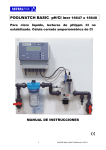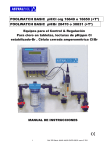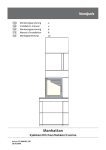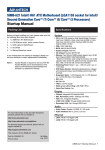Download LevelOne GSW-1601TX User's Manual
Transcript
LevelOne GSW-1601TX GSW-2401TX 16/24Port 10/100Mbps Switch with Gigabit option User's Manual (Vision 1.0) FCC Class A Appliance This equipment generates and uses radio frequency energy. If it is not installed and used properly in strict accordance with the manufacturer‘s instructions, it may cause interference to radio and television reception. It has been type-tested and found to comply the specifications in sub-part J of Part 15 of FCC Rules, which are designed to provide reasonable protection against such interference in a residential installation. There is no guarantee that interference will not occur in a particular installation. If this equipment does cause interference to radio or television reception which can be determined by turning the equipment off and on, the user is encouraged to try to correct the interference by one or more of the following measures: Re-orient the receiving antenna l Relocate the computing device with respect to the receiver l Move the computer away from the deceiver l Plug the computer into a different outlet so that compute and receiver are on different electrical circuits. If necessary the user should consult the dealer or an experienced radio or television technician for additional suggestions. The information in this manual is subject to change without notice. All the brand names are registered trademarks of their respective companies Contents Package List---------------------------------------------------------------------- iii Introduction---------------------------------------------------------1 Features------------------------------------------------------------------------------1 Identifying External Components---------------------------------3 Front Panel--------------------------------------------------------------------------3 Rear Panel---------------------------------------------------------------------------4 LED Indicators----------------------------------------------------------------------5 Connecting The Switch--------------------------------------------------5 Connecting End node or Hub or Switch--------------------------------------5 Connecting to Network Backbone or Server--------------------------------6 Configuration------------------------------------------------------8 Main Menu-------------------------------------------------------------------------9 Speed Mode-----------------------------------------------------------------------10 Address Learn---------------------------------------------------------------------12 VLAN--------------------------------------------------------------------------------13 Queues Priority-------------------------------------------------------------------16 Trunk--------------------------------------------------------------------------------17 Uplink Port-------------------------------------------------------------------------20 Monitor Port------------------------------------------------------------------------25 View Configuration---------------------------------------------------------------27 Restore To Factory Default----------------------------------------------------27 Switch Operation-----------------------------------------------------------28 i Troubleshooting--------------------------------------------------30 Technical Specifications---------------------------------------31 RJ-45 Pin Specification----------------------------------------32 ii Package List Check the contents of your package for following parts: l 16/24 Port 10/100Mbps Switch l User's manual l Power cord l 19” rack mount brackets. l RS232 cable If any of these pieces are missing or damaged, please contact your dealer immediately, if possible, retain the carton including the original packing material, and use them against to repack the product in case there is a need to return it to us for repair. iii INTRODUCTION The LevelOne GSW-1601/2401TX 16/24 Port 10/100/1000Mbps Switch with Gigabit option is designed to allow simultaneous transmission of multiple packets via an internal high-speed data channel. This means that it can partition a network more efficiently than bridges or routers in most environments. The LevelOne GSW-1601/2401TX 16/24 Port 10/100/1000Mbps Switch with Gigabit option is equipped with Category 5 copper cable or fiber optic cable for uplinking to a network backbone or network server. It is compatible with all 10Mbps, 100Mbps and 1000Mbps Ethernet environments. The increased speed and extra bandwidth offered by Gigabit Ethernet will support faster and more users applications with generating more traffic. In addition, the LevelOne GSW-1601/2401TX 16/24 Port 10/100/1000Mbps Switch with Gigabit option is also support one module slot for 2 Ethernet Gigabit ports to uplink to a server or network backbone. These Gigabit Switches are designed for Plug and Play installation, allows the network administrator to simply connect the network and power cables and the Switching/bridging functions begin automatically. The front panel of these Gigabit Switches provide LEDs for easy recognition of the switch operation status and for troubleshooting. These LEDs display the power status for the system and link/ speed/ collision, full-duplex, transmit and receive status for each port. The built-in console interface can be used to configure the Switch’s setting for Priority queuing, VLAN, and Port Trunk Groups, Port Monitoring and Port Speed. Features l l l Complies with the IEEE802.3 Ethernet, IEEE802.3u Fast Ethernet and IEEE802.3z/ IEEE802.3ab Gigabit Ethernet standard Provide a module slot for 2-port 10/100/1000T Gigabit Module (copper model: MDU-0201T) and 2-port 1000SXGigabit Fiber Module (fiber model: MDU-0200SX) option Features Store-and-Forward mode with wire-speed filtering and 1 l l l l l l l l l l l l l forwarding rates Full/ Half-Duplex capability on each TX port, full duplex only on 1000Base-TX port Automatic source address learning and aging. Support up to 16K MAC address Support up to total 64Mbit(16+2G), and 80Mbit (24+2G) packet buffers IEEE802.3x compliant full-duplex flow control, half-duplex flow control Broadcast storm control, runt and CRC Filtering eliminates erroneous packets to optimize the network bandwidth Support to handle up to 1536 bytes packet Internal power supply LED indicators for simple diagnostics and management Auto MDI/ MDI-X on all 10/100/1000Base TX ports Support one console port for switch configuration change Support per port Port-based VLAN and L2 Trunking with link fail-over Support IEEE802.1p four Priority queues on each port 2 I DENTIFYING E XTERNAL COMPONENTS This product series provide three different running speed – 10Mbps, 100Mbps, and 1000Mbps in the same hub and automatically distinguish the speed of incoming connection. This section describes the hardware features of these Gigabit Switches. For easier management and control of the switch, familiarize yourself with its display indicators, and ports. Front panel illustrations in this chapter display the unit LED indicators. Before connecting any network device to the hub, read this chapter carefully There are two different module for expansion: l 2 Port 10/100/1000T Gigabit Module l 2 Port 1000SX Gigabit Fiber Module Front Panel The unit front panel provides a simple interface monitoring the switching hub. It includes a power indicator for each port. 16 Port 10/100Mbps Switch with Gigabit option 24Port 10/100Mbps Switch with Gigabit option 16 Port 10/100Mbps Switch front panel 24 Port 10/100Mbps Switch front panel 3 2 Port 10/100/1000T Gigabit Module Front Panel 2 Port 1000SX Gigabit Fiber Module Front Panel LED Indicator Panel Refer to the next chapter for detailed information about each of the switch’s LED indicators. Twisted-Pair Ports Use any of these ports to connect stations or hubs to the switch. These ports are MDI-X ports, which means you can use ordinary straight-through twisted-pair cable to connect the switch to PCs, workstations, or servers through these ports. If you need to connect to another device with MDI-X ports such as another switch or hub, you should use a crossover cable, or connect using the Uplink port (described below). Rear Panel 16/24 Port 10/100/1000Mbps Switch with Gigabit option AC Power Connector: For the power cord. 4 LED Indicators LED Indicators LED Function Color Description PWR Green Lit: Power on SMART Green Lit: CPU installed LINK/ACT Green/Yellow Green Lit: 100Mbps, indicates the adapter is connected to hub and incoming Yellow Flash: 10Mbps, traffic entering the port 10/100 Green L10/100/1000 Lit: indicate link status and traffic speed (10/ L10 for 10M, 100/ L100 for 100M, 1000/ L1000 for 1000M) TX/ RX Green Lit: indicate data traffic status (TX for transmitting, RX for receiving) FDX/ COL Green Lit: Full-Duplex Flash: Half-Duplex/ Collision Off: Half-duplex or not connected Reset Switch At the left side of front panel, the reset switch is designed for reconfiguring the switch hub without turn off and on the power. C ONNECTING T HE S WITCH Connecting End node or Hub or Switch 1. Place the Switch on a smooth surface or fasten the mounting brackets with the provided screws in a standard 19” rack 2. Connect the DC jack of AC adapter to the DC inlet socket of Switch and the other end into the local power source outlet 5 3. Connect hub or PC to one port of the Switch using Category 3/4/5 UTP/STP cabling 4. Connect another hub or PC to the other port of Switch by following the same process as described in Step3. Notice: Cable distance for Switch The cable distance between Ethernet Switch and hub/PC should not exceed 100 meter; fiber cable distance shall not exceed 220 meter. Make sure the wiring is correct It can be used Category 3/4/5 cable in 10 Mbps operation. To reliably operate your network at 100Mbps and 1000Mbps, you must use an Unshielded Twisted-Pair (UTP) Category 5 cable, or better Data Grade cabling. While a Category 3 or 4 cable may initially seem to work,it will soon cause data loss. Connecting to Network Backbone or Server Connect to the Gigabit Ethernet ports with Category 5 copper cable or fiber optic cable for uplinking to a network backbone or network server. These ports operate at 1000Mbps in full-duplex mode. A valid connection is indicated when the Link LED is light. The following sections describe the function of LEDs on the front panel. CPU LED Color: Green Label: Smart Function: The LED light up steadily means CPU installed for smart function Power LED Color: Green Label: PWR Function: The LED light up steadily means Power turned on. 6 Link/ Speed LED Color: Green Label: L10/ L100/ L1000 Function: The LED light up steadily to indicate the transmitting speed L10: light up steadily to indicate link up at speed 10M L100: light up steadily to indicate link up at speed100M L1000: light up steadily to indicate link up speed 1G Full/ Half Duplex and Collision LED Color: Green Label: FDX/ COL Function: The indicator LED flash up whenever there is a collision between a directly attached end node and any other node, and light up steadily for Full-duplex mode. TX Activity Color: Green Label: LINK/ ACT Function: Each RJ45 station port on the hub is assigned one LED for Transmitting the data RX Activity Color: Green Label: LINK/ ACT Function: Each RJ45 station port on the hub is assigned one LED for receiving the data. 7 Configuration Connect TO PC RS-232 serial cable Prepare a RS-232 serial cable. Attach the 9-pin female connector to the male connector on the switch. Plug the other side of this cable to your PC Hyper Terminal In Windows 95/98, launch “HyperTerminal”, create a new connection, and adjust settings as below: 8 Main Menu Launch the new terminal you just set up, and then, turn on the switch. See the following messages for successful connection. 24-P 10/100M + 2-P 1G(COPER MODULE) switch Configuration menu [ver:3.12] [0] Port Setting [1] Address Learn [2] VLAN [3] Queues Priority [4] Trunk [5] Uplink Port [6] Monitor Port [7] View Configuration [8] Restore To Factory Default Select :>> To enter any of the submenus, simply type the number on the command line. 9 Speed Mode Entry: Select “0” from Main Menu. Purpose: Media Speed Control for each port. Default: All ports are auto- negotiation. 1.Input port number for which you want to configure, ’A’ or ‘a’ for select all port to configure, type ‘E’ or ‘e’ back to Main Menu, than press ENTER. For example, input port 1: which port ? (1 - 26 , 25=G1, 26=G2, E:Exit , A:Select all ports)... 1 Port Setting [1] Auto-negotiation [2] 10 Half Duplex [3] 10 Full Duplex [4] 100 Half Duplex [5] 100 Full Duplex Select :>> 2. Type 1-5 to select speed mode. Select :>> 1 Enable flow control ? (Y/N) 3. Type ‘Y’ ,’y’ or ‘N’ ,’n’ to enable or disable flow control , After finish flow -control selection, you can configure another port or type ‘E’ or ‘e’ , press ENTER back to main menu. 10 11 Address Learn Entry: Select “1” from Main Menu. Purpose: A port’s MAC address register is cleared on power-up, or hardware reset. If this item is enabled, the dynamically learned SA will be leared if it is not refreshed in less than the aging time. Default: Enable with aging time 5 minutes. Select :>> 1 Aging Control [E] Enable [D] Disable Example : Enable aging control with aging time 2 minutes. 1. type ‘E’ or ‘e’ to enable aging control Select :>> e Max address-aging timer Max aging time (1 - 10 minute)... 2. input ‘2’ for aging time and back to main menu 12 VLAN Entry: Select “2” from Main Menu. Purpose: Each port of the switch can be assigned to one or multiple VLANs(this device can be divided into 24 VLANs maximum). Frames from the source port will only be forwarded to destination ports within the same VLAN domain. A broadcast/multicast frame will be forwarded to all ports within the VLAN(s) of the source port except the source port itself. An unicast frame will be forwarded to the destination port only if the destination port is in the same VLAN as the source port. If the destination port belongs to the another VLAN, the frame will be discarded .Each port should be assigned with a dedicated uplink port. Unicast frames with unknown destination addresses will be forwarded to the uplink port of the source port. An uplink port can either be a single port or a trunk. Default: All ports assigned to one VLAN. Select :>> 2 VLAN VLAN Group 1 ,assigned ports>> [S] Port Select [D] Port Delete [A] Select All Ports [C] Save [E] Exit Select :>> Examples: Suppose the switch with 24 port , assigned port 1,2 to VLAN group 1 ,port 5,6 belong to VLAN group 2 ,others be assigned to VLAN group3 ,please follow below steps : 1. type ‘S’ or ‘s’ than input ‘1’ , press ENTER 13 Select :>> s Which Port To be Selected (1 - 26)..., (25 = G1 26 = G2) 1 VLAN VLAN Group 1 ,assigned ports>> 1 [S] Port Select [D] Port Delete [A] Select All Ports [C] Save [E] Exit Select :>> 2. type ‘S’ or ‘s’ than input ‘2’ ,press ENTER Select :>> s Which Port To be Selected (1 - 26)..., (25 = G1 26 = G2) 2 VLAN VLAN Group 1 ,assigned ports>> 1 2 [S] Port Select [D] Port Delete [A] Select All Ports [C] Save [E] Exit 3. type ‘C’ or ‘c’ , than you can see “Group 1 >> 1 2” on the screen ,that means VLAN group 1 with port 1,2 completed 14 Select :>> c Please Wait !! VLAN Group 1 >> 1 2 VLAN Group 2 ,assigned ports>> [S] Port Select [D] Port Delete [A] Select All Ports [C] Save [E] Exit Select :>> 4. repeat step 1 through 3 but input ‘5’ and ‘6’ to assigned [port 5 ,6 ] to next VLAN group ,than you can see the result below VLAN Group 1 >> 1 2 Group 2 >> 5 6 VLAN Group 3 ,assigned ports>> [S] Port Select [D] Port Delete [A] Select All Ports [C] Save [E] Exit Select :>> 5. type ‘E’ or ‘e’ will assigned others to VALN group 3 and back to main menu. 6. assigned with a dedicated uplink port for each VLANs, please refer to section of “Uplink Port” 15 Queues Priority Entry: Select “3” from Main Menu. Purpose: The switch can support priority either from tagged frame or based on the input ports. This entry is for port-based priority, level 0 stand for the lowest priority, level 7 as highest priority. Flow control will be disable if priority level 7 was selected . Default: All ports are cleared to priority zero on power-up, or hardware reset. Select :>> 3 which port ? (1 - 24 , E:Exit )... Example : Set port 1 to priority level 7. 1. input ‘1’ for select port 1 Priority level ? (0 - 7 , E:Exit )... 2. input ‘7’ priority level 7 which port ? (1 - 24 , E:Exit )... 3. type ‘E’ or ‘e’ back to main menu 16 Trunk Entry: Select “4” from Main Menu. Purpose: This switch can assigned port 1 – 8 to trunk 0 or trunk 1,port 9 – 16 to trunk 2 or trunk 3 , port 17 – 24 to trunk 4 or trunk 5, with L2 Trunking automatically load-balances among its member ports through the use of unique and statistical methods, and provides link resiliency (link-fail-over function) when one or more of the link in a trunk group fails. Default: All trunks disable. Select :>> 4 Trunk Which Trunk [0] Trunk 0 (Disable) [1] Trunk 1 (Disable) [2] Trunk 2 (Disable) [3] Trunk 3 (Disable) [4] Trunk 4 (Disable) [5] Trunk 5 (Disable) [6] Trunk 6 (Disable) [Giga] [E] Exit Examples: Suppose the switch with 24 port , assigned Trunk 0 with 3 ports member ,Trunk 2 with 8 ports member. follow below steps : 1. type ‘0’ to start trunk 0 setting 17 Select :>> 0 Trunk 0 ,member >> [A] Add [D] Delete [C] Setting [E] Exit 2. type ‘A’ or ‘a’ three times to assigned trunk port member Trunk 0 ,member >>port 1 2 3 [A] Add [D] Delete [C] Setting [E] Exit Select :>> 3. type ‘C’ or ‘c’ to finish setting Select :>> c Please Wait !! Which Trunk [0] Trunk 0 (1 2 3 ) [1] Trunk 1 (Disable) [2] Trunk 2 (Disable) [3] Trunk 3 (Disable) [4] Trunk 4 (Disable) [5] Trunk 5 (Disable) [6] Trunk 6 (Disable) [Giga] [E] Exit 4. Repeat step 1-3 but select trunk 2 and type ‘A’ or ‘a’ 8 times 18 Trunk 2 ,member >>port 9 10 11 12 13 14 15 16 [A] Add [D] Delete [C] Setting [E] Exit Select :>> c Please Wait !! Which Trunk [0] Trunk 0 (1 2 3 ) [1] Trunk 1 (Disable) [2] Trunk 2 (9 10 11 12 13 14 15 16 ) [3] Trunk 3 (Disable) [4] Trunk 4 (Disable) [5] Trunk 5 (Disable) [6] Trunk 6 (Disable) [Giga] [E] Exit 5. type ‘E’ or ‘e’ return to main menu 19 Uplink Port Entry: Select “5” from Main Menu. Purpose: The uplink port provides a way to connect the switch with a repeater hub, a workgroup switch, a router, or any type of interconnecting device compliance with IEEE 802.3 standards. Switch will send all frames with unmatched DA and multicast/broadcast frames to the uplink port. It is very important that each port is assigned to an uplink port, or data frames might be lost. The uplink port should be configured to be within the same VLAN as the source port. If the uplink port is not a member of the VLAN, the broadcast or multicast frames will not be forwarded to its designated uplink port. Multiple VLANs can share the same uplink port. Default: Disable Select :>> 5 Uplink Port UpLink Group 1 ,assigned ports>> [S] Port Select [D] Port Delete [A] Select All Ports [C] Continue [E] Exit Example : assume already configure two VLANs ,VLAN A have port 1 ,2 ,3 ,4 ,5, 6,7,8,9. others belong to VLANs B .assign uplink port 9 for VLANs A ,port 10 for VLAs B. 1. type ‘S’ or ‘s’ to select port Select :>> s Which Port To be Selected (1 - 26)..., (25 = G1 26 = G2) 2. input ‘1’ and press ENTER 20 1 Uplink Port UpLink Group 1 ,assigned ports>> 1 [S] Port Select [D] Port Delete [A] Select All Ports [C] Continue [E] Exit Select :>> 3. repeat step 1,2 to select port 2,3,4,5 ,6,7,8,9 ,then see the result below. UpLink Group 1 ,assigned ports>> 1 2 3 4 5 6 7 8 9 [S] Port Select [D] Port Delete [A] Select All Ports [C] Continue [E] Exit Select :>> 4. type ‘C’ or ‘c’ to continue Select :>> c Please Wait !! Uplink Port Select [A] port 1 [B] port 2 [C] port 3 [D] port 4 [E] port 5 [F] port 6 [G] port 7 [H] port 8 [I] port 9 [J] port 10 [K] port 11 [L] port 12 [M] port 13 [N] port 14 [O] port 15 [P] port 16 [Q] port 17 [R] port 18 [S] port 19 [T] port 20 [U] port 21 [V] port 22 [W] port 23 [X] port 24 [Y] port G1 [Z] port G2 Select :>> 5. type ‘I’ or ‘i’ to select uplink port ,as you can see bellow, “Group 1 >> 1 2 3 4 5 6 7 8 9 --> uplink to port 9” means port 1,2,3,4,5 ,6,7,8,9,have uplink to port 9. 21 Select :>> e Uplink Port Group 1 >> 1 2 3 4 5 6 7 8 9 --> uplink to port 9 UpLink Group 2 ,assigned ports>> [S] Port Select [D] Port Delete [A] Select All Ports [C] Continue [E] Exit Select :>> 6. repeat steps1 –5 to assign others to uplink port 10 ,as result below: Select :>> j Uplink Port Group 1 >> 1 2 3 4 5 6 7 8 9 --> uplink to port 9 Group 2 >> 10 11 12 13 14 15 16 17 18 19 20 21 22 23 24 --> uplink to port 10 UpLink Group 3 ,assigned ports>> [S] Port Select [D] Port Delete [A] Select All Ports [C] Continue [E] Exit Select :>> 7. type ‘E’ or ‘e’ back to main menu 22 Link to another switch via signal port or TRUNK port Please create a uplink port for any port or trunk-port you want to cross link to another switch, there is a example for 16 + 2G cross link via G1 port ,refer to the steps under : 16-P 10/100M + 2-P 1G(COOPER MODULE) [ver:3.12] [0] Port Setting [1] Address Learn [2] VLAN [3] Queues Priority [4] Trunk [5] Uplink Port [6] Monitor Port [7] View Configuration [8] Restore To Factory Default Select :>> 5 Uplink Port UpLink Group 1 ,assigned ports>> [S] Port Select [D] Port Delete [A] Select All Ports [C] Continue [E] Exit Select :>> a Please Wait !! 23 UpLink Group 2 ,assigned ports>> [S] Port Select [D] Port Delete [A] Select All Ports [C] Continue [E] Exit Select :>>e 24 Monitor Port Entry: Select “6” from Main Menu. Purpose: The switch supports port monitoring. This feature provides complete network monitoring capability at 100 Mbit/s. A copy of egress (TX) data and ingress (RX) data of the monitored port is sent to their respective snooping ports. Default: Disable Select :>> 6 Monitor Port [M] Monitored Port [I] Monitoring Port for Incoming Packets [O] Monitoring Port for Outgoing Packets [D] Disable Port Monitor [E] Exit Select :>> Example : Monitored Port 1 , Monitoring for incoming packets port 2, Monitoring for outgoing packets port 3. 1. type ‘M’ or ‘m’ to select Monitored Port Select :>> m Which port to be monitored (1 - 24)... 2. input ‘1’ and press ENTER 3. repeat step1 –2 for monitoring port incoming packets and outgoing packets. 25 4. type ‘E’ or ‘e’ back to main menu. 26 View Configuration Entry: Select “7” from Main Menu. Purpose: Diplay configuration of port setting,address learn,VLAN,priority,trunk,uplink port, monitor port. Select :>> 7 [Port Setting] F:full duplex ,H:half duplex ,Y:flow control enable ,N:flow control disable [ 1] Auto /Y [ 2] Auto /Y [ 3] Auto /Y [ 4] Auto /Y [ 5] Auto /Y [ 6] Auto /Y [ 7] Auto /Y [ 8] Auto /Y [ 9] Auto /Y [10] Auto /Y [11] Auto /Y [12] Auto /Y [13] Auto /Y [14] Auto /Y [15] Auto /Y [16] Auto /Y [17] Auto /Y [18] Auto /Y [19] Auto /Y [20] Auto /Y [21] Auto /Y [22] Auto /Y [23] Auto /Y [24] Auto /Y [G1] Auto /Y [G2] Auto /Y [Address Learn] aging times = 5 minutes press any key to continue ... [Current VLAN] Group 1 >> 1 2 3 4 5 6 7 8 9 10 11 12 13 14 15 16 17 18 19 20 21 22 23 24 G1 G2 press any key to continue ... 27 [Priority] [ 1]=0 [ 2]=0 [ 3]=0 [ 4]=0 [ 5]=0 [ 6]=0 [ 7]=0 [ 8]=0 [ 9]=0 [10]=0 [11]=0 [12]=0 [13]=0 [14]=0 [15]=0 [16]=0 [17]=0 [18]=0 [19]=0 [20]=0 [21]=0 [22]=0 [23]=0 [24]=0 [G1]=0 [G2]=0 [Current TRUNK] Disable press any key to continue ... [Current UpLink] Group 1 >> 1 2 3 4 5 6 7 8 9 --> uplink to port 9 Group 2 >> 10 11 12 13 14 15 16 17 18 19 20 21 22 23 24 --> uplink to port 10 [Monitor Port] Disable press any key to continue ... Restore To Factory Default Entry: Select “8” from Main Menu. Purpose: Restore to the default setting as mention before. 28 Switch Operation Address Table The LevelOne 16/24 Port 10/100/1000Mbps Switch with Gigabit option is implemented with an address table. This address table composed of many entries. Each entry is used to store the address information of some node in network, including MAC address, port no, etc. This information comes from the learning process of Ethernet Switch.. Learning When one packet comes in from any port. The LevelOne 16/24 Port 10/100/1000Mbps Switch with Gigabit option will record the source address, port no. and the other related information in address table. This information will be used to decide either forwarding or filtering for future packets. Forwarding & Filtering When one packet comes from some port of the Ethernet Switching, it will also check the destination address besides the source address learning. The Ethernet Switching will lookup the address-table for the destination address. If not found, this packet will be forwarded to all the other ports except the port which this packet comes in. And these ports will transmit this packet to the network it connected. If found, and the destination address is located at different port from this packet comes in, the Ethernet Switching will forward this packet to the port where this destination address is located according to the information from address table. But, if the destination address is located at the same port with this packet comes in, then this packet will be filtered. Thereby 29 increasing the network throughput and availability Store-and-Forward Store-and-Forward is one type of packet-forwarding techniques. A Store-and Forward Ethernet Switching stores the incoming frame in an internal buffer, do the complete error checking before transmission. Therefore, no error packets occurrence, it is the best choice when a network needs efficiency and stability. The Ethernet Switch scans the destination address from the packet-header, searches the routing table provided for the incoming port and forwards the packet, only if required. The fast forwarding makes the switch attractive for connecting servers directly to the network, thereby increasing throughput and availability. However, the switch is most commonly used to segment existing hubs, which nearly always improves overall performance. A Ethernet Switching can be easily configured in any Ethernet network environment to significantly boost bandwidth using conventional cabling and adapters. Due to the learning function of the Ethernet switching, the source address and corresponding port number of each incoming and outgoing packet are stored in a routing table. This information is subsequently used to filter packets whose destination address is on the same segment as the source address. This confines network traffic to its respective domain, reducing the overall load on the network. The Gigabit Switch performs "Store and forward" therefore, no error packets occur. More reliably, it reduces the re-transmission rate. No packet loss will occur. Auto-Negotiation The STP ports on the Gigabit Switch have built-in “Auto-negotiation”. This technology automatically sets the best possible bandwidth when a connection is established with another network device (usually at Power On or Reset). This is done by detect the modes and speeds at the second of both device is connected and capable of, Both 10Base-T and 100Base-TX devices can connect with the port in either Half- or Full-Duplex mode. 1000Base-TX and 1000Base-SX can only connected Full-duplex mode. 30 Troubleshooting This chapter contains information to help you solve problems. If LevelOne GSW-1601/2401TX 16/24 Port 10/100/1000Mbps Switch with Gigabit option is not functioning properly, make sure the Ethernet Switch was set up according to instructions in this manual.. l The Link LED is not lit Solution: Check the cable connection and remove duplex mode of LevelOne GSW-1601/2401TX 16/24 Port 10/100/1000Mbps Switch with Gigabit option l Some stations can not talk to other stations located on the other port Solution: The address table may contain older information than of the address table of that node. Please power down to refresh the address information. 31 T ECHNICAL S PECIFICATIONS l l l l l l l l l Standard: IEEE802.3. IEE802.3u, IEEE802.3z, IEEE802.3ab Network Media: 10Base-T – UTP/STP category 3 or 5 cable 100Base-TX – UTP/STP category 5 cable 1000Base-TX, 4 pairs category 5 cable 1000Base-SX, Multi-mode 62.5/125µm fiber optic cable Connector: STP RJ-45 port TX SC connector for 1Gbps FX LED indicators: System – Power OK LED. Individual port: 10/100Mbps TX ports– link/activity, speed, duplex and collision LEDs Gigabit copper port: Link1000, Link 100, Link 10, FDX/Col,, TX, RX activity LEDs Gigabit port: Link, Activity LEDs Dimension: 440mm x 245mm x 45mm Temperature: Operating – 0? to 50? Storage – -20? to 70? Humidity: Operating – 10% to 90% RH Storage – 5% to 90% RH Input Power Requirement: 100 - 240VAC, 50 – 60Hz, Auto-sensing Registrations: FCC Part 15 Class A, CE 32 RJ-45 P IN S PECIFICATION When connecting your LevelOne GSW-1601/2401TX 16/24 Port 10/100/1000Mbps Switch with Gigabit option to another switch, a bridge or a hub, a modified crossover cable is necessary. Please review these products for matching cable pin assignment. The following diagram and tables show the standard RJ-45 receptacle/connector and their pin assignments for the switch-to-network adapter card connection, and the straight / crossover cable for the Switch-to-switch / hub / bridge connection. RJ-45 Connector pin assignment Contact Media Direct Interface Signal 1 TX + (transmit) 2 TX - (transmit) 3 Rx + (receive) 4 Not used 5 Not used 6 Rx - (receive) 7 Not used 8 Not used The standard cable, RJ-45 pin assignment The standard RJ-45 receptacle/connector 33 The following shows straight cable and crossover cable connection: Straight cable for Switch (uplink MDI-II port) to switch/Hub or other devices connection Crossover cable for Switch (MDI-X port) to switch/hub or other network devices (MDI-X port) connection 34



















































